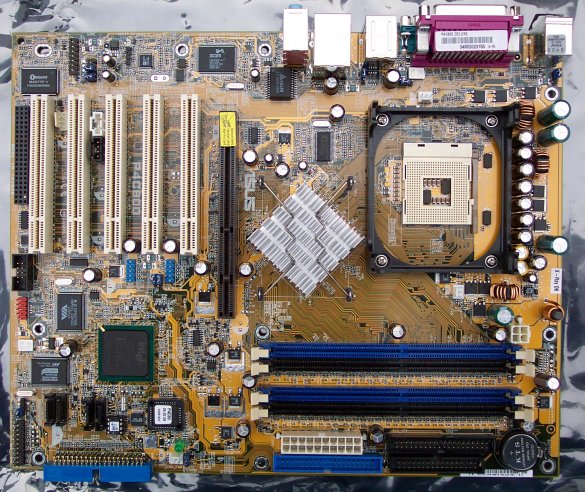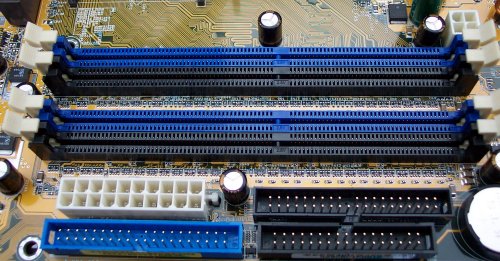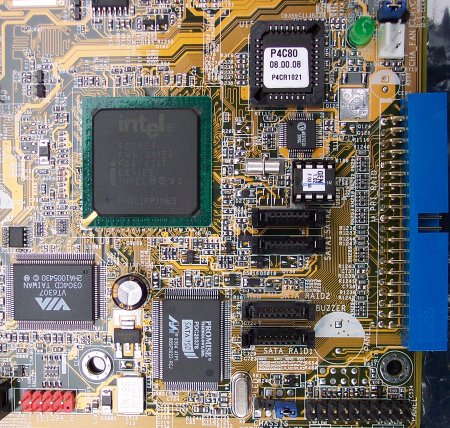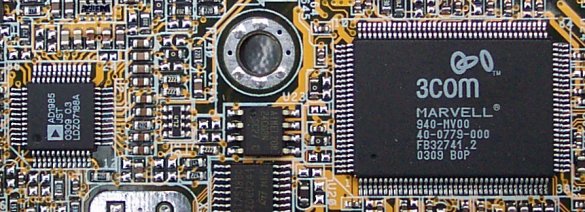Asus P4C800D Layout and Features

Generic PCB colours seem to be Asus' preferred presentation. Another busy-looking motherboard. That's a little surprising with the degree of integration offered by the ICH5. A seemingly small point, but I do like the care and attention Asus have taken with respect to the retention bracket. It's screwed in properly, unlike the plastic pins used on most boards. There are two fan headers close by for cooling duties.

A bank of capacitors line the side of the rotated ZIFF socket. Asus haven't gone with extra passive cooling.

The 4-pin 12v power connector is located in the strangest of places, just above the first DIMM slot. It's actually a pretty good location as the trailing wires don't have to traverse the motherboard. Asus have kindly colour-coded the DIMM slots required for dual channel operation. Use either blue or black or both. It's all a bit tight around the IDE port locations. You may find it a little difficult if your preferred IDE cables have side locks on them.

A reasonably small passive heatsink covers the 200FSB Intel i875P MCH. It's also well held on with clips on all four sides. However, it's a little too close to the AGP slot. Running a Zalman-equipped Radeon 9700 Pro resulted in the upper Zalman heatsink making a slight contact with the NB heatsink. It shouldn't be a problem with other stock cards, but there's little need to have the MCH heatsink in such close proximity to the AGP slot. The slot doesn't feature a locking mechanism either.

The business end as far as hard drives are concerned, be it S-ATA or P-ATA. A standard ICH5 Southbridge provides support for 2 IDE ATA100 channels and 2 independent S-ATA (v1.0) channels. The BIOS allows you to toggle between your preferred method of hard drive usage, much like the MSI board. There's no RAID function in the standard ICH5. That job, Asus feel, is best left to the Promise PDC20378. This hybrid controller powers a single IDE channel( above right) and two S-ATA channels. Given that it supports both standards you can mix and match S-ATA and P-ATA to provide differing levels of RAID. With a possible 4 drive combination, RAID levels of 0, 1 and 0+1 are open to you. VIA's 2-port VT6307 takes care of Firewire duties.

A special Wi-Fi (Wireless Fidelity) slot is provided and can be used with the optional Asus module. Using this slot dictates that the 5th PCI cannot be used at the same time. The backplane excludes the usual second COM port. The motherboard integrates it on to the PCB even though the adapter required for it to function wasn't bundled. A red Firewire port sits to the right.

More goodies. This time for networking and audio. The small CODEC on the left is the impressive AD1985 AC'97 v2.3 from Analog Devices. Once coupled with the also all-new SoundMax XL software, it's a highly potent 6-channel, 20-bit audio solution. A feature that Asus term as audio Ai is Soundmax's ESP technology. It recognises if you're inputting a peripheral in the wrong jack and informs you of its correct location. Geekily impressive.
Intel's Canterwood specification put great store in the dedicated Gigabit Ethernet link between the controller and MCH. Much was made of how this allowed full-duplex operation without saturating the comparatively-starved PCI bus. Asus, though, have gone with 3COM's Gigabit LOM (LAN on motherboard). This connects to the chipset through the usual PCI-to-Southbridge route. Why have Asus chosen this over the more elegant Intel design ?. Probably on the basis of cost. It's rumoured that 3COM's controller is substantially cheaper than Intel's, and with this board more aimed at the enthusiast sector we doubt that the full-duplex ability of the Intel fifth-generation 82547EI Gigabit Ethernet Controller will be used in a home environment.

A single RCA S/PDIF-out takes the place of the usual second serial port. It would have been nice to have an optical-out socket, too. 4 USB2.0 ports, the Gigabit jack and a single Firewire port give the user some degree of high-speed flexibility. The audio jacks double up in 6-channel mode and provide auto-sensing capability.









